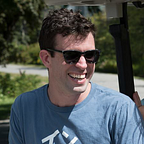DFINITY @ Nasdaq Intro & Part 1: Olaf Carson-Wee & Dominic Williams Discuss Autonomous Software and Decentralized Infrastructure
Thursday, the 28th of June, 2018, the DFINITY team met at the Nasdaq Entrepreneur Center to support Dominic Williams, Chief Scientist and founder of DFINITY, while he participated in two panel discussions. One panel featured Olaf Carson-Wee, Founder of Polychain Capital, and another with Ed Knight, Chief Regulatory Officer of Nasdaq and Kathryn Haun, General Partner at Andreessen Horowitz. Both panels were moderated by Bruce Aust of Nasdaq.
The event was notable not only because it took place on the home turf of one of the world’s largest stock exchanges, but also because the two panels digested the perspectives of top investors and technologists alongside that of traditional exchanges and regulators.
This post features Dominic’s preliminary interview with Bruce Aust of Nasdaq, and a brief synopsis of his panel discussion with Olaf Carlson-Wee. Part 2 will feature a short presentation introducing DFINITY, and a groundbreaking panel with Ed Knight, Kathryn Haun, and Dominic Williams.
“A blockchain is a mechanism that makes it possible to build decentralized networks that provide a service without the central point of failure of controlling organization. Bitcoin is a store of value built using blockchain, Ethereum is a smart contract platform built using blockchain, and DFINITY is an internet computer built using blockchain” — Dominic Williams
Cryptocurrencies and Autonomous Software
Cryptocurrencies were described as tokens with fixed supply, the value of which varies with demand. They are the first stable application of blockchain technology and initially intended as payment mechanisms. Today however experimentation is occurring with services beyond just payments — stable tokens, decentralized exchanges, and financial derivatives with more non-financial services being developed for release in the near future.
New platforms are enabling autonomous software, such as the blockchain-based world computer, DFINITY. Autonomous software exists and runs independently, governed and mediated not by a central organisation, but rather by a broadly distributed token. This kind of software will be able to provide decentralized services which, due to there being no central point of failure or censorship (platform risk) will be preferable to centralized alternatives.
“Autonomous software is just software that by merit of it having some kind of economic backing can exist independently of some kind of individual or organisation” — Dominic Williams
Companies outlive people and now blockchain based organisations, powered by autonomous software, can do the same, while enjoying the benefits of an open, permissionless platform to build on.
“To me, this kind of organisation is really the next evolution of business governance and structure” — Olaf Carlson-Wee
“We think the potential of this thing is unlimited — the whole world runs on software” — Dominic Williams
Decentralized Infrastructure
Olaf pointed out that the top 5 capitalized companies today are all internet companies which are built using an open, network. They have achieved their size due to the absence of platform risk.
“Today, when these companies have board meetings they don’t fret or fear the internet being shut down or the internet being censored. It is a fully open platform that anyone can build on. With blockchains you have the ability to build similarly open and permissionless financial systems.” — Olaf Carlson-Wee
Meta-Assets and More Powerful Platforms
In discussing “Meta-Assets”, Olaf identified Mastercoin (now Omni) and Counterparty as examples built using Bitcoin. The ERC20 token on Ethereum was the first system to experience broad success. The enabling feature being Ethereum’s flexible scripting language.
“Today you see more transaction volume on Ethereum in assets other than ether than in ether itself” — Olaf Carlson-Wee
Other ways exist to improve the underlying protocol: improvements in governance, improved programmability using the next generation WebAssembly programming standard, and improved consensus mechanisms. Also new “Layer 2” protocols that enhance the deepest layer. There are many experiments taking place in many dimensions.
Regulation
Dominic pointed out that most ICOs are run using Ethereum, which is designed to be unstoppable. As such it is likely to be very difficult to stop ICOs from happening. US regulators need to be careful not to exclude the US tech economy from this explosion in capital formation. Regulatory agencies are here to facilitate that capital formation, but need to regulate in such a way that bad actors are targeted.
“It’s at this point uncontroversial, I think, to say that ICOs represent the most efficient form of capital formation we have ever seen” — Olaf Carlson-Wee
Should Blockchain be Feared?
Dominic stated that blockchain is not a belief system, and it offers more than just a global currency. It can address fundamental, practical problems, and make it less expensive to develop, maintain, and administer business systems. However, Olaf was more cautious, describing it as a novelty from an esoteric background.
“Worldwide there are lots of businesses and governments that are constantly pained by the expense of developing IT systems . . . making them secure and keeping user data private, so you know, we are addressing really fundamental practical problems and when you look at it like that there is nothing to fear.” — Dominic Williams
“I don’t think there is nothing to fear here. . . now that we have unlocked peer to peer money it will never go away. This is an unstoppable force . . . the governments of the world couldn’t stop Bitcoin . . . Peer to peer systems are in a sense to be feared if you are a central banker or whoever else has been used to just controlling these systems. . . The genie is out of the bottle and at this point it is somewhat inevitable.” — Olaf
Check in next week for part 2 in this series
